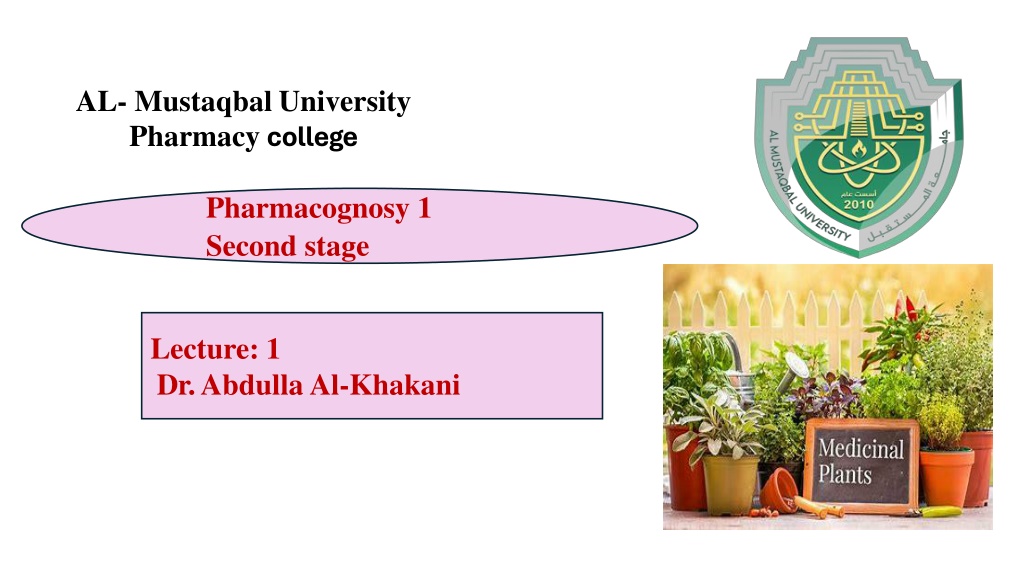
Understanding Pharmacognosy: Study Approaches and Plant Nomenclature
Explore the study of pharmacognosy, focusing on substances derived from natural sources and plant-based medicinal drugs. Learn about different approaches to studying medicinal plants and the principles of botanical nomenclature. Dive into the fascinating world of pharmacognosy and plant taxonomy with this informative content.
Download Presentation

Please find below an Image/Link to download the presentation.
The content on the website is provided AS IS for your information and personal use only. It may not be sold, licensed, or shared on other websites without obtaining consent from the author. Download presentation by click this link. If you encounter any issues during the download, it is possible that the publisher has removed the file from their server.
E N D
Presentation Transcript
AL- Mustaqbal University Pharmacy college Pharmacognosy 1 Second stage Lecture: 1 Dr.Abdulla Al-Khakani
Introduction Introduction to Pharmacognosy Pharmacognosy is the study of those substances or drugs derived from natural sources (animals, plants, or micro-organisms). The word pharmacognosy is derived from the Greek Pharmacon which means a drug & gnosis which means science. Pharmacognosy forms an important link between pharmacology and medicinal chemistry on one hand and between pharmaceutics and clinical pharmacy on the other hand.
Approaches to the study of medicinal plants Vegetable drugs can be arranged for study under the following headings: 1. Alphabetical: Either Latin or vernacular names may be used.This arrangement is employed for dictionaries, pharmacopoeias, etc. Although suitable for quick reference it gives no indication of interrelationships between drugs. 2. Taxonomic: The drugs are arranged according to the plants from which they are obtained, in classes, orders, families, genera & species. It allows for a precise and ordered arrangement and accommodates any drug without ambiguity 3. Morphological: The drugs are divided into groups such as leaves, flowers, fruits, seeds, herbs, etc These groupings have some advantages for practical study of crude drugs & identification of powdered drugs is often based on micro-morphological characters.
Approaches to the study of medicinal plants 4. Pharmacological or Therapeutic: This classification involves the grouping of drugs according to the pharmacological action of their most important constituents or their therapeutic use.This type of listing is found increasingly in the literature. However, it is important to appreciate that the constituents of any one drug may fall into different pharmacological groups. 5. Chemical or Biogenetic: The important constituents (e.g., alkaloids, glycosides, volatile oils, etc.) or their biosynthetic pathways form the basis of classification of the drugs. This is a popular approach when the teaching of pharmacognosy is phytochemically biased.
Plant nomenclature taxonomy Botanical nomenclature: In the past the plants were known by a double Latin tittle but Linnaeus (1707-1778) who is a Swedish biologist was the first to describe the present binomial system in which the first name denotes the species. All species names may be written with small initial letters while the genus name starts with a capital letters.
Plant nomenclature taxonomy Botanical names are followed by the names of a person or their accepted abbreviations E.x: Mentha piperita Linnaeus or Mentha piperita L. This name (Linnaeus) refers to the botanist who first described the species or variety. This name is useful where there are different names for the same plant. Then plant family with capital letter Example: Belladona Botanical name: Atropa belladonna (Family: solanaceae)
Natural sources of drugs An examination of the list of drugs derived from natural sources , reveals the followings: 1. Plant : example alkaloids. Fungi : The fungi provide a number of useful drugs especially antibiotics, & are important in pharmacy in a number of other drugs. 3. Algae : These are source of limited number of drugs ex: agar & alginic acid. 4. Land animals : It provides traditional pharmaceutical materials ex: gelatin , wool fat , beeswax & are a source of hormones, vitamins & sera. 5. Bacteria: bacteriophyta is a source for the production of antibiotics substrates and th employments in genetic engineering ex: in the production of human insulin.
Methods of using plants 1. Plants may be used as isolated parts e.g. dried leaves of plant as digitalis which contain glycosides as digoxin which is used for the treatment of heart diseases and congestive heart failure. 2. Whole plant e.g. Catharanthus roseus & its active constituent vincristine & vinblastine which are used as anticancer.
Methods of using plants 3. Extract of active constituents e.g. extract of unripe fruit of plant as Papaver somniferum which contains morphine which is used as narcotic. The resultant extract is called extractive which refers to the principles constituents found in natural substances & are separated or isolated from the natural substances by different means of extraction these principles are responsible for the medicinal activities of the natural substances & these are found either single or mixtures.
Medical terms in pharmacognosy Crude drug: Natural products which are not pure compounds. plants: plants that are just that, they have grown in wild with very little help from humans.it grows on its own without human interference. Primary metabolites: metabolite excreted during the growth phase they mainly contain carbon, nitrogen& phosphorus ex. sugars, amino acids, and nucleotides. They give rise to secondary metabolites, & they are very important for plant (plant cannot live without primary metabolites)
Secondary metabolites: are different chemical compounds produced from primary and have pharmacological activity for human being and many functions inside the plant but plant can live without secondary metabolites example: alkaloids, glycoside and others. Alkaloids: basic compounds containing at least one or more nitrogen atom in a heterocyclic ring or outside the ring, occurring chiefly in many vascular plants & fungi. Glycoside: are compound that yield upon hydrolysis, one or more sugar molecules with an organic hydroxide and non sugar part (aglycone). Most glycoside are found in plants& exhibit different pharmacological activities.
Volatile oils: rapidly evaporating oil of plant derivation(volatilize at ordinary temperature) ,also called essential oil (have odor). Fixed oil: nonvolatile fatty oil of vegetable origin consisting mainly of glycerides. Tannin: phenolic substances of plant origin used in tanning and in medicine. Tannins can precipitate proteins , alkaloids & convert hide into leather. Extraction: methods of obtaining the active constituents found in plants. extraction removes only those substances that can be dissolved in liquid or liquid mixture which is referred to as the solvent or more specifically called menstrum.
Marc: the un dissolyed portion of the substance that remains after the extraction process is completed. Extract: solvent used after extraction process is completed.
















